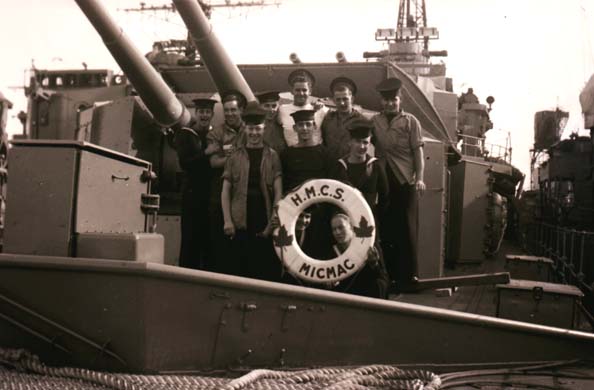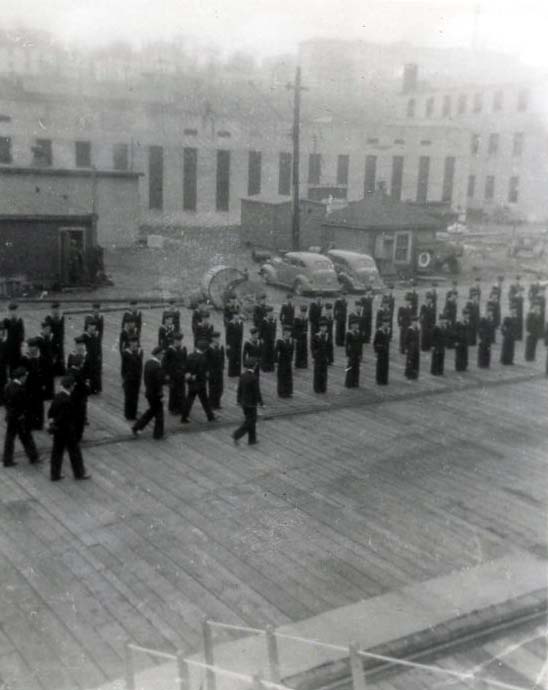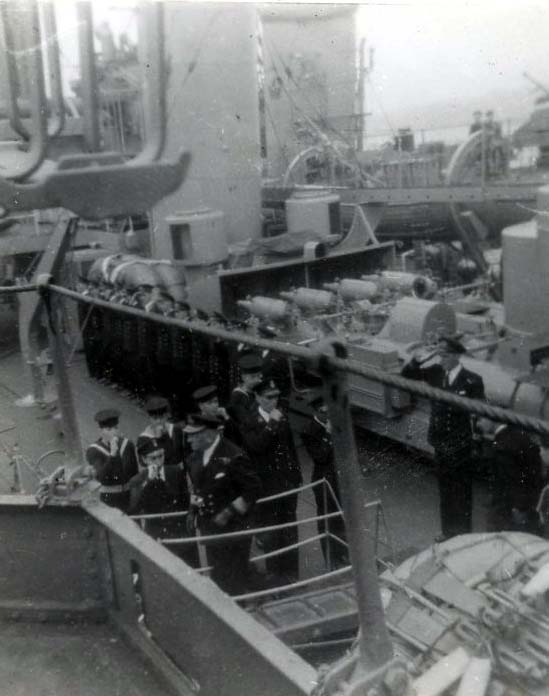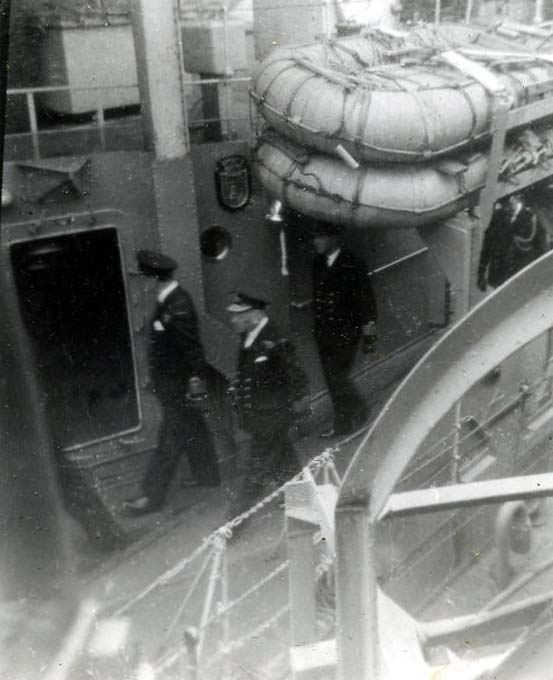![]()
![]()
 |
| Micmac crew from the summer of 1945. Can anyone identify the personnel? Contact: jerry.proc@sympatico.ca. (Photo by Bob Scott) |
Click on any photo to enlarge.
| After the collision with Yarmouth County, MICMAC was paid into reserve but later it was decided to partially convert her to a destroyer escort. A triple barrelled Squid was mounted at 'A' position and a quad 40 mm gun at 'B'. There were two twin 4 inch mountings aft and a further four single Bofors. The conversion was finished on the 16th of November 1949. The young sailor in the photo is Walter Emery. (Photo via Walter Emery) | |
| Walter Emery is standing in front of MICMAC's
port propellor while the ship is in drydock. (Photo via Walter
Emery)
|
CAPTAIN (D)
 |
 |
 |
| Captain (D) (name unknown) is inspecting the ships company of HMCS Micmac likely in mid 1940's. (All photos in this table from the collection of E.G. Piccioni) |
David Shirlaw indicates "In Royal Navy tradition, Captain (D) would be in charge of a flotilla of eight destroyers and would be in command of the flotilla leader, a ninth ship. The only flotilla leader that the RCN had was HMCS Margaree. The practice of the 9th ship ended with the RN Tribals when the leader became one of the eight destroyers. In the 1940s, the RCN would have a Captain (D) in charge of the ships in various ports such as Halifax. Cdr Peter Chance (Ret'd and XO of Iroquois and Cayuga) recalls. "My recollection follows the RN tradition only in that we had a Captain (D) ashore in Halifax during part of WWII. That probably lapsed sometime in the mid to late 1940's. In Londonderry there was a Commodore (D)".Bud Flanagan also remembers. "My first recollection of Captain (D) was in 1947 when then Commander H.F. Pullen assumed command of HMCS Nootka. We painted the black ring on her forward funnel as a result. The only destroyers in that flotilla were Nootka and HMCS Haida. HMCS Micmac was in for repairs as a result of collision damage. The second memory I have was when I was GI of Restigouche in 1959. She was the first of the 257 class. When St. Croix was commissioned, she joined us in Fort Lauderdale and the 5th Squadron was born. Restigouche wore the black ring on the funnel. Gradually all seven of the class formed the full squadron and in either 1960 or or 1961 all seven were tied up alongside in San Juan".
Cdr. Bob Willson (RCN Ret'd) recalls the Cold War era. After WWII, the practice of naming a Captain (D) disappeared when various reorganizations were implemented (such as NATO) and the RCN began to shed much of the Royal Navy nomenclature. Also, the formation of NATO led to some changes in command structure. During the Korean war, the senior Canadian, usually a Captain, was designated Commander Canadian Destroyers Far East.
As the RCN grew after Korea, and with the development of the Cold War, ships were formed into squadrons, of varying sizes, which were designated either Destroyer Squadrons or Escort Squadrons. The Commanders were called Commander (number) Canadian Escort Squadron e.g. CANCOMCORTRON3 or CANCOMDESRON5 , etc.
In the RN, the Squadron Commander, or Captain (D) , usually commanded one of the ships in the Squadron, and the accommodation in that ship was modified somewhat to provide space for his staff. In literature, these ships are sometimes referred to as Destroyer Leaders. During WWII it is believed that the Canadian Captain (D) actually stayed shore in Halifax or St. Johns.
In the RCN, from the late 1950s and early 1960s, the Squadron Commander and his staff were usually a separate group and he did not actually command a specific ship, except in the Minesweeping Squadrons. In the St. Laurent Class, and later classes, the Captain's Cabin had two bedrooms and the CO and the Squad Boss shared the accommodation.
In the older destroyers, the CO moved into the XOs Cabin and everyone else moved down one. There were some exceptions. In the late 1950s, after the Korean War for instance, Captain Hennessy was Commander First Canadian Escort Squadron (CANCOMCORTRON ONE), composed of Algonquin, Prestonian, Lauzon and Toronto, and also CO of Algonquin, although his XO at the time, Ken Grant carried out a lot of the duties of CO, and commanded the ship whenever Hennessy was somewhere else.
A Captain (D), or a Squadron Commander did not have any distinguishing marks on his uniform. Depending on the particular year or period, the ship he was in wore a black band around the funnel or in the case of DDHs, around the mast structure. That was the situation up into the late 1980s. The organization is somewhat different now with ships organized into Groups rather than squadrons".
Buster Brown ( RCN , Ret'd) reminisces. " The term Captain (D) in the post-war RCN was widely used in the 1st, 2nd 3rd and 5th squadrons of destroyers among the Squadron staffs and visual and radio communications folks. From my perspective, it tended to whither away at about the time of the onslaught of WW2 retirees from about 1964 to 1971 lending to the idea that the slang vs. the wartime recognized acronym was replaced with D1, D2 etc. extracted from CANCOMDESRONONE, TWO etc. COM was the indication of he being the Commander of the appropriate squadron and that CANDESRON were the assigned ships of that squadron.
When a Captain (D) was riding any ship in his squadron, his pennant would be flown from the mainmast. Uniform wise, Captain (D) was only identified by his face"
Contributors and Credits:1) Scott, Robert T. AB V90944 <rscott(at)havensupportservices.com>
2) Brian J Piccioni <bjpiccioni(at)gmail.com>
3) Bob Willson <rawillson(at)rogers.com>
4) David Shirlaw <djshirlaw(at)shaw.ca>
5) Bud Flanagan <Budflanagan(at)aol.com>
6) Buster Brown <retsubmarine(at)eastlink.ca>
Sept 16/12